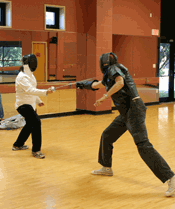As a young boy, my parents introduced me to classic films featuring Errol Flynn ("Captain Blood") and Douglas Fairbanks Jr. ("The Corsican Brothers"). I mainly remember the swashbucklers' fencing duels.
When I saw "The Princess Bride" as a teenager, I thought the sword-fighting scenes were the best things about it. Who could forget Mandy Patinkin's character, Inigo Montoya, saying: "Hello. My name is Inigo Montoya. You killed my father. Prepare to die," before an epic sword battle with the movie's villain? Then there's the duel between Westley (Cary Elwes) and Montoya: timeless.
I thought that's what fencing was, but all that changed after a visit to the Central Mississippi Fencing Club in Clinton.
Richard Jones founded the school in 2002. Jones is a certified instructor for the United States Fencing Association and has been fencing competitively for more than 12 years. He fences both left and right handed and trains fencers in all three types of weapons used in the Olympic games.
Jones began a lesson for my wife, Lacey, Mike Loftin and me by explaining the salute. Before and after each lesson, fencers salute their teachers; in competition, they salute each other, the judges and the spectators.
To salute, a fencer starts with the sword pointed toward the floor across the front of the legs. He or she then brings the sword up vertically in front of the face. The final move brings the sword across the body to the other side away from the legs.
Fencing is won and lost with the feet, I learned, and I have two left feet, so my swordplay might never be great. My hands also have a life of their own with a sword in them. I felt like the most inept fencer, ever, but Jones said that with time and practice even I could become a decent fencer.
"Fencing matches at the highest level are won and lost determined by which fencer keeps their balance and hands correct," Jones repeatedly explained.
The original meaning of fencing comes from the Latin defensum, "the act of defending." Lighter fencing weapons began to increase in popularity with the invention of firearms, which made heavy medieval armor obsolete along with the huge broadswords of the time. Smaller swords such as rapiers, a thrusting sword and sabres, a slashing sword, came into favor with the upper classes who used them most commonly in duels.
With young European hotheads engaging in fencing duels, training became paramount, and schools popped up in Spain, Italy, France, and England in the mid 15th and early 16th century.
Many looked down on dueling to the death—more noblemen died from duels than in battles in the early 16th century—and dueling to first blood became the norm. This eventually led to a technique called the "first touch with right of way." This development, which gave the fencer making the "first touch" the winner of the bout or point, with the loser giving the "right of way," resulted in dueling and sporting victories without disabling or killing one's opponent.
Over time, fencing began to fade from popularity, until the modern Olympic games revived interest. "The original founders of the games were fencers," Jones says. Fencing is one of only four sports to be included in every summer Olympic Games since 1896; the other three are athletics (now known as track and field), swimming and gymnastics.
Jones taught us several terms in fencing such as "parry," a defensive action after an attack, and "riposte," which is an offensive counter-attack to the parry. He also showed us the types of weapons used in Olympic fencing.
The "foil" is a light thrusting weapon. In competition with a foil, a fencer's targets are restricted to the torso, the chest, shoulders and back. Double touches are not allowed. This weapon follows the rules of "right of way," or priority, to determine which fencer's hit will prevail when both fencers hit.
The "épée" is a heavy thrusting weapon. The épée's target area covers the entire body, and double touches are allowed. There is no "right of way" in épée fencing.
The "sabre" is a light cutting and thrusting weapon. Using a sabre, the fencer's target area begins at the waistline, and up, including the head but not the hands. Sabre bouts follow the rules of "right of way." The sabre is also used for training because of its light weight.
Fencing bouts are contested on a narrow, raised platform known as a "piste," which is 15 meters long and 2 meters wide.
After the lesson, we joined Jones and coach David Williams to meet and learn from several wheelchair fencers. Williams has 35 years of fencing experience and, like Jones, coaches the Blade Rollers wheelchair fencing team. In November, two of the Blade Rollers traveled with the U.S. wheelchair fencing team to Paris for the 2010 World Championships.
All told, the U.S. wheelchair fencing team has 10 members, with four from Mississippi: Sonia Fogal, nominated as the female Athlete of the Year in fencing for the 2009 AT&T State Games of Mississippi; Joey Brinson, an accomplished wheelchair fencer; Ryan Estep; and Rebekka Sides. Brinson finished 21st in Men's Sabre and 25th in Men's épée, and Estep finished 24th in Men's Foil and 23rd in a épée.
To learn fencing, call Richard Jones at 601-942-7307, or visit http://www.clintonfencing.com.



Comments
Use the comment form below to begin a discussion about this content.